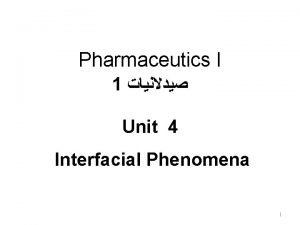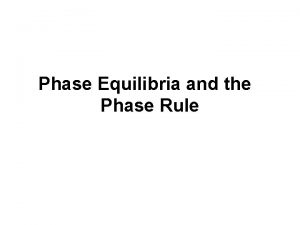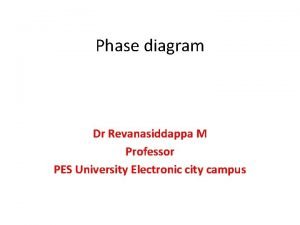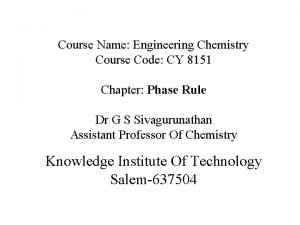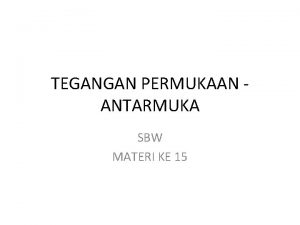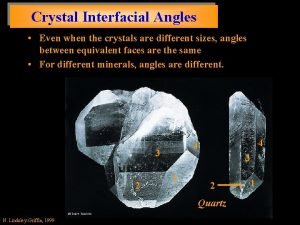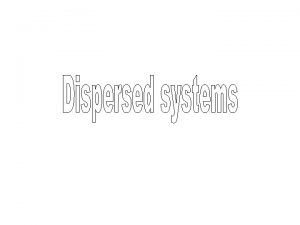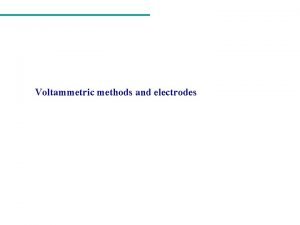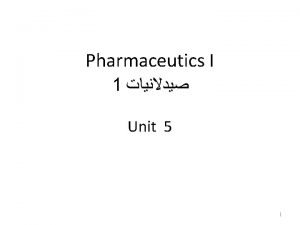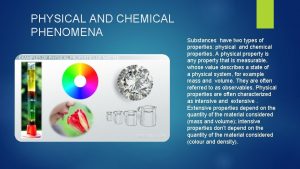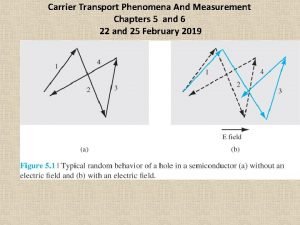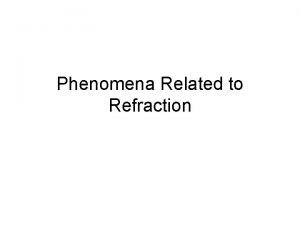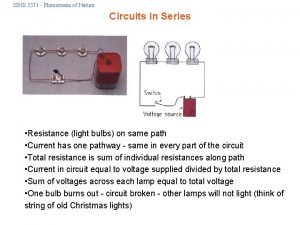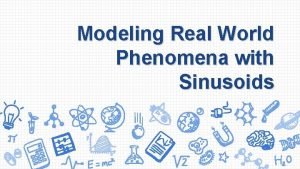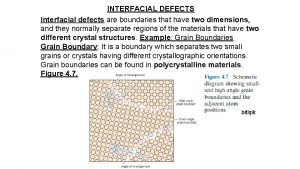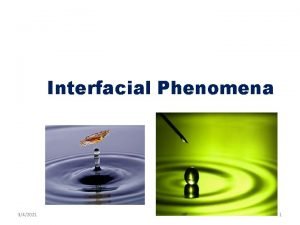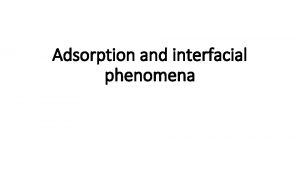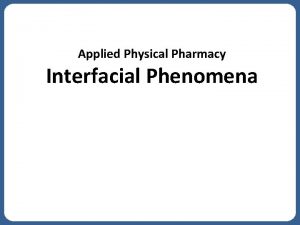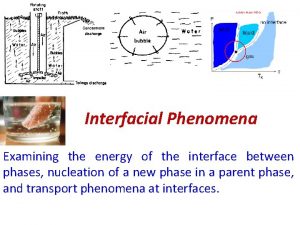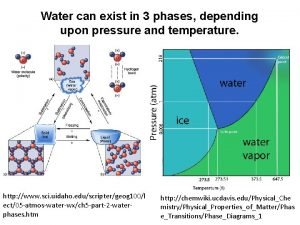Interfacial Phenomena Interfacial Phenomena When phases exist together





































- Slides: 37

Interfacial Phenomena

Interfacial Phenomena • When phases exist together, the boundary between two of them is termed an interface. • The properties of the molecules forming the interface are often sufficiently different from those in the bulk of each phase that they are referred to as forming an interfacial phase.

Interfacial Phenomena SURFACE TENSION INTERFACIAL TENSION

Interfacial Phenomena Several types of interface can exist, depending on whether the two adjacent phases are in the solid, liquid or gaseous state.

Interfacial Phenomena Classification of Interfaces Phase Interfacial Tension Types & Examples of Interface Gas - gas - No interface possible Gas - liquid у. LV Liquid surface, body of water exposed to atmosphere Gas - solid y. SV Solid surface, table top Liquid - liquid y. LL Liquid-liquid interface, emulsion Liquid - solid y. LS Liquid-solid interface, suspension Solid - solid y. SS Solid-solid interface, powder particles in contact.

Surface and Interfacial Tension Surface • The term surface is commonly used when referring to either a gas-solid or a gas-liquid interface. • “Every surface is an interface. ”

Cause of surface tension Surface tension is caused by the attraction between the liquid's molecules by various intermolecular forces. In the bulk of the liquid: each molecule is pulled equally in all directions by neighbouring liquid molecules net force of zero. At the surface of the liquid, molecules are pulled inwards by other molecules deeper inside the liquid and are not attracted as intensely by the molecules in the neighbouring medium. i. e. : -- They develop attractive cohesive forces with other liquid molecules situated below & adjacent to them. -- They create adhesive forces of attraction With the other phase involved at the interface.



Surface tension- a force pulling the molecules of the interface together resulting in a contracted surface. - Force per unit length applied parallel to the surface. Unit in dynes/cm or N/m

Interfacial tension • Is the force per unit length existing at the interface between two immiscible liquid phases and like surface tension, has the units of dyne/cm


Surface Free Energy To move a molecule from the inner layers to the surface , work must be done against the force of surface tension. In other words , each molecule near the surface of liquid possesses a certain excess of potential energy as compared to the molecules in the bulk of the liquid. The higher the surface of the liquid, the more molecules have this excessive potential energy.

• Therefore , if the surface of the liquid increases , e. g. when water is broken into a fine spray), the energy of the liquid also increases. Because this energy is proportional to the size of the free surface, it is called a surface free energy. • Each molecule of the liquid has a tendency to move inside the liquid from the surface ; therefore the liquid takes form with minimal free surface and with minimal surface energy. for example , liquid droplets tend to assume a spherical shape because a sphere has the smallest surface area per unit volume.



Surface Free energy W=γ∆A where W is work done or surface free energy increase expess in ergs(dyne cm); γ is surface tension in dynes/cm and ∆ A is increase in are in cm sq. Q. What in the work required to increase area of a liquid droplet by 10 cm sq if the surface tension is 49 dynes/cm? W = 49 dynes/cm x 10 cm sq = 490 ergs

Spreading Coefficient When oleic acid is placed on the surface of a water , a film will be formed if the force of adhesion between oleic acid molecules and water molecules is greater than the cohesive forces between the oleic acid molecules themselves.

• Work of adhesion (Wa), which is the energy required to break the attraction between the unlike molecules(water to oil) Figure 15 -7 Representation of the work of adhesion involved in separating a sublayer and an overlaying liquid

Work = Surface tension x Unit area change Accordingly, it is seen in figure 15 -7 that the work done is equal to the newly created surface tensions , y. L and YS , minus the interfacial tension , YLS that has been destroyed in the process. Wa= YL+YS-YLS

Work of cohesion ( Wc ), required to separate the molecules of the spreading liquid so that it can flow over the sublayer. L L L Figure 15 -8 Representation of the work of cohesion involved in separating like molecules in a liquid

• Obviously , no interfacial tension between the like molecules of the liquid , and when the hypothetical 1 –cm sq cylinder in figure 15 -8 is divided , two new surfaces are created each with surface tension of YL, therefore the work of cohesion is Wc =2 YL

• Spreading of oil to water occurs if the work of adhesion (a measure of the force of attraction between the oil and the water) is greater than the work of cohesion. • The term (Wa-Wc) is known as the Spreading coefficient(S)

If it is Positive – the oil will spread over a water surface. S=(YL+YS-YLS) -2 YL rearrangement : S= Ys-YL-YLS Or S= Ys – (YL+YLS)

• Spreading occurs (S is positive) when the surface tension of the sublayer liquid is greater than the sum of the surface tension of the spreading liquid and interfacial tension between the sublayer and the spreading liquid. • If (YL+YLS)is greater than YS , the substance forms globules or a floating lens fails to spread over the surface. An example is mineral oil on water.

Example 15 -7 • If the surface tension of water Ys is 72. 8 dyne /cm at 20° C , the surface tension of benzene YL is 28. 9 dyne/cm and the interfacial tension between benzene and water , YLS, is 35 dyne /cm. What is the initial spreading coefficient? Answer: S = 72. 8 - (28. 9+ 35) = 8. 9 dyne/cm

Effects of Molecular Structure on Spreading Coefficient(S) • Polar groups such as COOH or OH such as propionic acid and ethanol have high values of S. • Increase in carbon chains of acids will lead to decrease of polar-nonpolar character ratio thus decrease in S on water. Ex are nonpolar liquid petrolatum fail to spread on water. • Benzene spreads in water because of its weak cohesive forces.

For lotions with mineral oil base to spread freely and evenly on the skin , its polarity and spreading coefficient should be increase by the addition of surfactants.

Substance Ethyl alcohol Propionic acid Ethyl ether Acetic acid Acetone Undecyclenic acid Oleic acid Chloroform Benzene Hexane Octane Ethylene dibromide Liquid petrolatum S (dynes/cm) 50. 4 45. 8 45. 5 45. 2 42. 4 32 (250) 24. 6 13 8. 9 3. 4 0. 22 -3. 19 -13. 4

• Certain molecules and ions , when dispersed in the liquid , move of their own to the interface. Their concentration at the surface then exceed their concentration in the bulk of the liquid. • the surface tension of the system automatically reduced ( why? ) • Such a phenomena when the added molecules are partitioned in favor of interface is called adsorption. • The molecules and ions that are adsorbed at the interface are termed surface active agents or surfactant or ( amphiphile )


For the amphiphile to be conentrated at the interface , it must be balanced with the proper amount of water and oil soluble groups. If the molecule is too hydrophilic , it remains within the body of the aqueous phase and exert no effect at the interface. If it was too hydrophobic , it dissolves completely in the oil phase.

Reduction of surface and interfacial tension The reason for the reduction in the surface tension, when surfactant molecules adsorb at the water surface is that the surfactant molecules replace some of the water molecules in the surface and the forces of attraction between surfactant and water molecules are less than those between two water molecules, hence the contraction force is reduced.

• • • Surfactants are classified as: Anionic Cationic Non-ionic and Ampholytic

• ANIONICS: Sodium Dodecylsulphate: CH 3(CH 2)11 SO 4 - Na+ • CATIONIC: Dodecylamine hydrochloride: CH 3(CH 2)11 NH 3+ Cl-

• NON-IONICS: Polyethylene Oxides: e. g. CH 3(CH 2)11(O-CH 2)n. OH Spans (sorbitan esters) Tweens (polyoxyethylene sorbitan esters) • AMPHOLYTICS: Dodecyl betaine: C 12 H 25 N+(CH 3)2(CH 2 COO-)

Hydrophilic-Lipophilic Balance (HLB) It is an arbitrary scale from 0 to 20 serve as a measure of the Hydrophilic/Lipophilic balance of a surfactant. • Products with low HLB are more oil soluble. • High HLB represents good water solubility. • The oil phase of the oil – water(o/w) emulsion requires a specific HLB , called the required hydrophilic –lipophilic balance (RHLB). • A different RHLB is required to form a water-in oil emulsion(w/o) from the same oil phase.
 Surface and interfacial phenomena
Surface and interfacial phenomena Salol thymol system
Salol thymol system Pattinson process phase diagram
Pattinson process phase diagram Cy 8151
Cy 8151 Energi bebas permukaan adalah
Energi bebas permukaan adalah Interfacial
Interfacial Interfacial porn
Interfacial porn Talc luster
Talc luster Define dispersed system
Define dispersed system Electroanalytical
Electroanalytical State of matter
State of matter Oligeneous
Oligeneous Suspending agent example
Suspending agent example Marco koper
Marco koper Moose monikko
Moose monikko Critical angle and total internal reflection
Critical angle and total internal reflection Observable phenomena
Observable phenomena Contemporary phenomena
Contemporary phenomena Business research methods lecture notes ppt
Business research methods lecture notes ppt Is gravity a natural phenomenon
Is gravity a natural phenomenon Physical and chemical phenomena
Physical and chemical phenomena Optical phenomena rainbow
Optical phenomena rainbow Reoulox phenomena
Reoulox phenomena Phenomena and noumena
Phenomena and noumena Natural language processing
Natural language processing Noumena vs phenomena
Noumena vs phenomena Carrier transport phenomena
Carrier transport phenomena Refraction phenomena
Refraction phenomena Noumena vs phenomena
Noumena vs phenomena Global climate phenomena
Global climate phenomena Real world sinusoidal functions
Real world sinusoidal functions Reference phenomena in nlp
Reference phenomena in nlp Noumena vs phenomena
Noumena vs phenomena Anchor phenomena
Anchor phenomena Observable phenomena
Observable phenomena Random phenomena
Random phenomena Brigitte falkenburg
Brigitte falkenburg Colloids and interfaces
Colloids and interfaces
